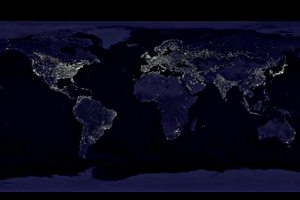 The earth at night as viewed from a space, in a composite image from NASA.
The earth at night as viewed from a space, in a composite image from NASA.
The world is not as dark as it used to be. Streetlights, parking lot security lights, office building lights, and neon signs shine all through the night. Light pollution can come directly from light bulbs, or it can bounce off of dust and water droplets in the air, creating a bright haze called skyglow. This 24-7 illumination can be seen from space, and it has negative effects on humans and wildlife. But there are ways to dim the lights and reduce their effects—and save energy in the process.
Astronomers have long aware of the problems associated with nighttime illumination—it makes stars disappear. Big telescopes are built away from big cities for this reason, although bright lights have a way of encroaching. QUEST blogger Ben Burress talks about light pollution and astronomy here and here.
Non-astronomers are affected by nighttime lighting, too; exposure to light at night affects our circadian rhythm, the 24-hour cycle deep inside our bodies. Seeing light at night can cause sleep disorders. And long-term exposure to light at night has been linked to breast cancer, because light inhibits the production of melatonin, which slows the growth of cancer cells.
